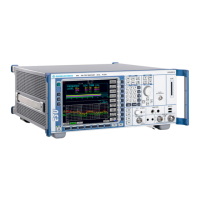Operating Manual 1302.6163.12 - 03 8.7
R&S ESU Maintenance and Instrument Interfaces
Instrument Interfaces
8.3.3 RS-232-C Interface (COM)
The standard R&S ESU is equipped with a RS-232-C serial interface. The interface
can be set up and activated manually in the SETUP-GENERAL SETUP menu in the
COM INTERFACE table (selection OWNER = INSTRUMENT) for remote control.
For details on the connector refer to the Quick Start Guide, chapter 1.
8.3.3.1 Interface Characteristics
• Serial data transmission in asynchronous mode
• Bi-directional data transfer via two separate lines
• Transmission rate selectable from 110 to 138000 baud
• Logic '0' signal from +3 V to +15 V
• Logic '1' signal from -15 V to -3 V
• External instrument (controller) can be connected
Fig. 8.52 Pin assignment of the RS-232-C interface
8.3.3.2 Signal Lines
• DCD (Data Carrier Detect)
Not used in R&S ESU.
Input; active LOW.
Using this signal, the local terminal recognizes that the modem of the remote
station receives valid signals with sufficient level. DCD is used to disable the
receiver in the local terminal and prevent reading of false data if the modem
cannot interpret the signals of the remote station.
• RxD (Receive Data)
Input, LOW = logic '1', HIGH = logic '0'.
Data line, local terminal receives data from remote station.
• TxD (Transmit Data)
Output, LOW = logic '1', HIGH = logic '0'.
Data line, local terminal transmits data to remote station.
• DTR (Data Terminal Ready)
Output, active LOW,
Indicates that the local terminal is ready to receive data.
1
5
6789
234
DCD
RxD
TxD
DTR
SG
DSR
RTS
CTS
RI

